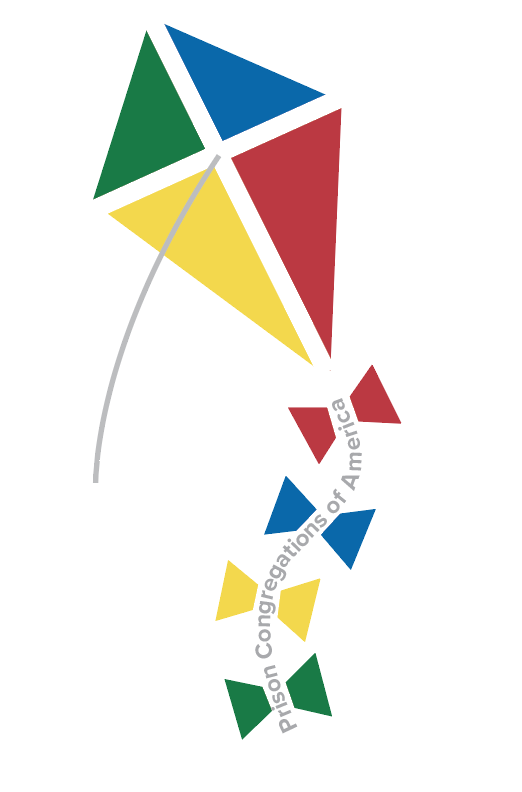
THE KITE
The significance of the PCA kite logo is multi-faceted. First, in many prisons across the United States the “kite” is a form of communication.
Informally, notes passed from inmate to inmate using a variety of creative methods to reach cell to cell, are sometimes referred to as “kiting.”
Formally, in order for inmates to make requests to speak to a pastor, mental health counselor, or other professional within the prison facility they are required to fill out a short “memo” of sorts commonly referred to as a “kite.” Once the request is completed, depending on the facility protocol, the inmate can then drop the kite into the internal mailing system and wait for a response.
The kite is extremely important within correctional facilities in that it is the primary method for inmates to express a need or ask a question by initiating dialogue with a member of the prison staff.
So, the kite is PCA’s symbolic reminder of the scripture in Hebrews 13:3 that tells us to, “Remember those who are in prison as if you were their fellow prisoner…”
Expanding upon the meaning within the prison setting, the kite is an extraordinary expression of the freedom we have through Christ to communicate directly with the Creator of the Universe through prayer and all the wondrous liberty the relationship affords us as children of God. No walls, no fences, no razor wire can stand in the way of the prayers of God’s people reaching the throne of grace, therein enabling those who cry out for God’s redeeming peace, through His Spirit, to attain it.
With that, the kite is also PCA’s symbolic representation of II Corinthians 3:17 which says:
“Now the Lord is the Spirit, and where the Spirit of the Lord is there is freedom.”
When considering the individual parts of the kite’s construct and the forces of flight, the symbolic significance becomes even more powerful.
This is called a quadrilateral wind blown kite. It is a polygon with four edges and four corners.
Notice the perfect circle inscribed and the cross that holds the shape of the kite.
Three distinctive parts to this kite body:
The perfect internal circle
The cross
The external polygon covered with a light material that air (wind) moves across to create “lift.”
These three (Trinity) work together as one to create the aerodynamic construct by which the kite is able to overcome gravity and take flight.
The four forces of flight are:
Lift – The upward force that pushes the kite into the air
Weight – The downward force generated by gravity
Thrust – The forward force that propels a kite in the direction of motion
Drag – The backward force that acts opposite the direction of motion
To launch a kite into the air the force of lift must be greater than the force of weight. To keep a kite flying steady the four forces must be in balance. Lift must be equal to weight and thrust must be equal to drag. [Courtesy of The Smithsonian National Air & Space Museum]
Of course, the kite needs a line of tension in order to experience sustainable lift by the wind. That line of tension is connected to the kite body (specifically, the cross) by what’s referred to as a bridle. The kite string is then attached to the bridle allowing the flyer on the ground to “fly” the kite.
What an amazing analogy of the Christian life and the continuous tension between our flesh and our spirit!
What’s more is that a kite pivots and dives at the point where the bridle attaches to the connecting string. Wow!
The Spirit of God is referred to again and again in the Bible as “wind,” the critical element to winged flight of any variety. In this case, the body of the kite is like a wing, lifted against the gravitational pull by the pressure and direction of the wind. Is it any wonder the number of references to eagles in the Bible – masters of majestic flight.
What about the kite’s tail? What does it do?
Generally, flying a kite without a tail results in the kite spinning and rolling continuously. There is nothing smooth (or peaceful) about the experience. The kite’s tail has an amazing stabilizing effect by adding necessary weight and drag to its lower end. The tail helps the forces of flight achieve balance so the kite is able to fly as it was designed to do – freely and unencumbered, stable and sustained.
PCA’s desire is to work in concert with the wind of Holy Spirit to be, in effect, that tail.
A pastor called to start a church in prison does not need PCA to do so. There are prison congregations today that PCA did not assist in establishing. However, our hope is that both the history and the ongoing capacity of this organization will serve as a key component in offering a safe, stable, and sustainable centering for the men and women who devote themselves to starting and perpetually nurturing robust communities of faith inside and outside prisons.
The work can be isolating, extremely challenging, ever changing, and exceptionally draining at times. It may seem like the spinning and rolling will never come to an end. As the essential forward motivating THRUST continually pushes against the backward driving DRAG, the result can be exhausting at best. With God’s help and the continued support of the beloved people who faithfully give into this ministry, we are committed to providing meaningful tools and substantive resources that pour life into the pastors and volunteers in the trenches in the same way they give so liberally of themselves to their congregates inside prison and those reintegrating back to society.



